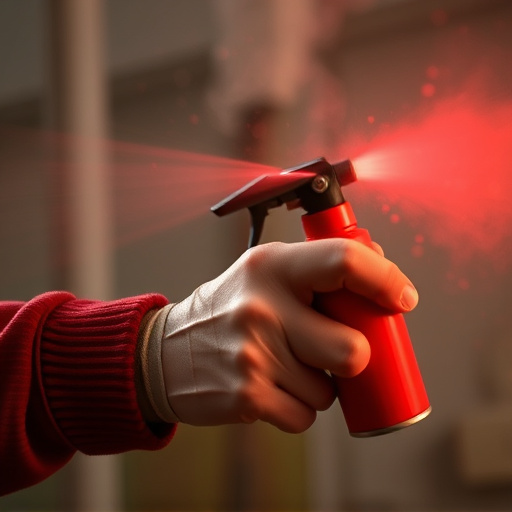Prompt removal of pepper spray from clothing using soap, warm water, or specialized solutions is crucial to prevent skin irritation and stains. Understand local laws regarding ownership and usage, safely dispose of contaminated items, and maintain tools for optimal self-defense practices.
In today’s world, personal safety is paramount. One innovative approach gaining traction is non-lethal inflammatory self-defense tools, offering a balance between deterrence and minimal harm. This article explores these unique defenses, from understanding their mechanics to practical applications. We delve into common options, focusing on pepper spray—its uses, removal techniques from clothing (including fast methods), and legal considerations. Learn effective strategies to enhance your safety and peace of mind.
- Understanding Non-Lethal Inflammatory Tools
- Common Non-Lethal Self-Defense Options
- Removing Pepper Spray From Clothing Fast
- Legal Considerations for Self-Defense
- Effective Strategies for Personal Safety
Understanding Non-Lethal Inflammatory Tools
Non-lethal inflammatory tools, such as pepper spray, have become increasingly popular for self-defense purposes. These devices are designed to cause temporary disorientation and pain, enabling users to escape potential threats without inflicting serious harm. Pepper spray, in particular, is a common choice due to its effectiveness in neutralizing attackers by irritating the eyes and respiratory system.
Understanding how these tools work is crucial when it comes to their proper use and maintenance. For instance, knowing how to remove pepper spray from clothing promptly is essential for minimizing exposure and discomfort. Simple methods include using soap and warm water or specialized cleaning solutions to ensure clothes are thoroughly cleaned after contact with non-lethal inflammatory agents, preventing long-lasting stains and potential health risks.
Common Non-Lethal Self-Defense Options
In today’s world, individuals are increasingly seeking non-lethal self-defense options for personal safety. Beyond traditional self-defense classes and carrying a firearm, there is a growing interest in non-violent tools that can deter attackers without causing severe harm. One of the most common and effective choices is pepper spray, designed to temporarily disable an assailant by irritating their eyes and respiratory system.
Removing pepper spray from clothing after use is crucial for safety and comfort. Unlike traditional spices or substances, pepper spray’s active ingredients remain potent on fabrics unless properly removed. Simple methods include washing with soapy water, using specialized decontaminant wipes, or following manufacturer instructions for safe disposal. Understanding how to manage such tools and their byproducts ensures users can protect themselves effectively while minimizing secondary risks.
Removing Pepper Spray From Clothing Fast
If you’ve been targeted with pepper spray while wearing clothing, quick action is crucial to minimize its effects and remove the residue. Start by removing any contaminated garments from your body as soon as possible. Don’t wash them immediately; instead, place them in a sealed plastic bag to preserve evidence of the attack.
Next, use a mild soap and warm water to gently clean the affected skin areas. Pepper spray is an irritant, so be careful not to rub it into your skin. Focus on rinsing thoroughly with plenty of water for at least 15 minutes. For clothing, pre-treat stains using a commercial pepper spray remover or a mixture of baking soda and vinegar. After treatment, wash the items separately in hot water to ensure all traces of the spray are eliminated.
Legal Considerations for Self-Defense
When considering any form of self-defense, including non-lethal inflammatory tools like pepper spray, understanding legal implications is paramount. Each jurisdiction has its own set of laws and regulations regarding self-defense, and what’s permitted can vary widely. For instance, some areas may allow individuals to carry pepper spray for personal protection, while others might restrict it to law enforcement or require permits.
One crucial consideration is how to properly use and remove pepper spray from clothing after an incident. Removing pepper spray from garments and skin without proper precautions can lead to prolonged discomfort and potential health risks. It’s essential to follow guidelines provided by manufacturers for safe disposal, as well as state laws dictating the handling of such substances. This includes knowing local regulations on carrying and using non-lethal self-defense tools, ensuring compliance with legal requirements at all times.
Effective Strategies for Personal Safety
Personal safety is a paramount concern in today’s world, and individuals must be equipped with effective strategies to defend themselves against potential threats. One innovative approach gaining traction is the use of non-lethal inflammatory self-defense tools, offering a powerful yet safe alternative for deterring aggressors. These tools are designed to cause temporary discomfort, enabling users to escape dangerous situations without causing permanent harm.
When it comes to personal safety, one crucial tactic is removing pepper spray from clothing immediately after exposure. Pepper spray, a popular non-lethal defense mechanism, can remain potent and sticky, causing continued irritation if left on fabrics. Users should have a dedicated bag or container for storing and transporting their self-defense tools, ensuring easy accessibility while also keeping them separate from regular belongings. Prompt removal of pepper spray from clothing not only enhances the effectiveness of your defense but also minimizes potential cross-contamination in public spaces.
Non-lethal inflammatory tools, such as pepper spray, offer a crucial option for personal safety. Understanding these devices and their legal implications is essential. Knowing how to quickly remove pepper spray from clothing, as demonstrated in this article, can be a game-changer during unexpected encounters. By combining practical skills with strategic self-defense techniques, individuals can better navigate potentially dangerous situations, ultimately enhancing their safety and peace of mind. Remember, staying informed and prepared is key to fostering a safer environment.
